The most common “starter” questions we get from real estate investors about on-page SEO is… “what meta keywords should I use?” and “how many times should I use my keyword in each page?“.
5 or 6 years ago “meta tags” and “meta keywords” were all the rage. You’d cram your meta keywords section with 20 keywords… and it actually worked.
Now… not so much. (as in, don’t do it, meta keywords and keyword density don’t really matter anymore)
To help you visualize the “perfect” on-page SEO optimization process for a web page, I thought you’d love this infographic below.
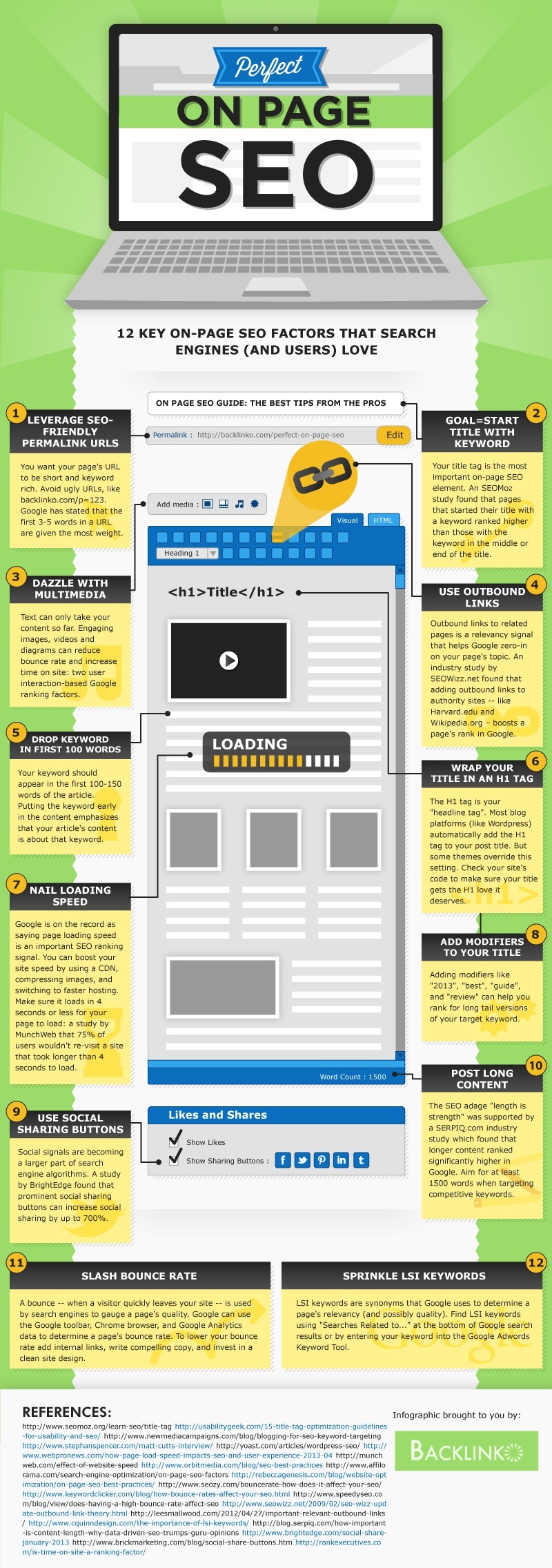
The Perfect On Page SEO Guide: Hat tip to Brian at Backlinko for putting this awesome yet simple infographic together of 12 important onpage SEO factors.
The 12 Core Factors To On-Page SEO On Your Real Estate Investing Lead Gen Site
These elements are all already built into every InvestorCarrot website.
So lucky you if you’re a member of ours!!!! We love ya! If you’re not a member… (there’s still time to come over and leverage the most effective online inbound marketing platform for real estate investors alive).
Now lets dive in to each element a bit deeper and show you what we mean.
1. Leverage SEO Friendly URLs
One way Google knows about what is on your page is by the URL of that particular page.

See how in that picture above, when you search that phrase how Google highlights the keywords in the URL? That shows us that Google recognizes that stuff and likely figures it into their ranking factors. That Carrot website is ranked #1 in Google for several really competitive phrases in California and has closed at least 4 deals specifically from the leads he’s generated from his Carrot website this past 6 months.
As another example, this screenshot below is of a clients website. He owns one of the top home buying firms in the country (1500+ deals done) and this page is climbing in the search rankings after our team tweaked up their on-page SEO… including the URL to include the keyword phrase we know sellers are typing in in that market.
Action Item: Make sure that when you create pages on your website that you want to rank… to try to include a variation of the keyword phrase you’re looking to rank for in the URL. It’ll help Google recognize what your website is about that much easier.
2. Goal = Start Title w/ Keyword
Your title tag on your real estate investing website is the most important factor in your SEO. A Moz study showed that websites with their main keyword at the start of the title tag tended to rank better for that phrase than the pages where the keyword was in the middle of the title tag.
As you can see in the screenshot below from inside an SEO tool… the keyword phrase they’re trying to rank for is “sell inherited house Detroit”. Then in the “SEO Title” (title tag) box that exact same keyword phrase is the first thing in the title tag.
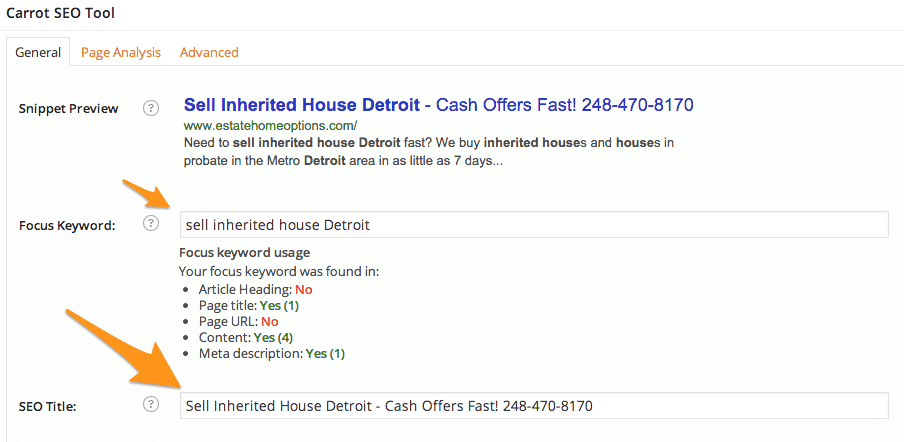
Action Item: Make sure you update your title tags on your pages so they have the keyword phrase you’re looking to rank for at the start.
3. Dazzle With Multi-Media
This isn’t a requirement to rank well, but we’ve found it sure can help.
Try to include a picture, video, etc. on every page that you really want to rank well. This includes blog posts. There are several reasons… but among them are that engaging images and media can keep someone on your page longer which reduces your bounce rate. Google likes websites that engage the visitors and uses bounce rate as a part of their overall ranking factors.
Look at this example from one of our customer’s website below. Look how engaging it is with local images, his smiling face and bio, etc. Make your pages more engaging with media!
(NOTE: When you add pictures to your pages, make sure to include variations of your keywords in the “alt text” of each image. That way Google can tell what the image is about.)
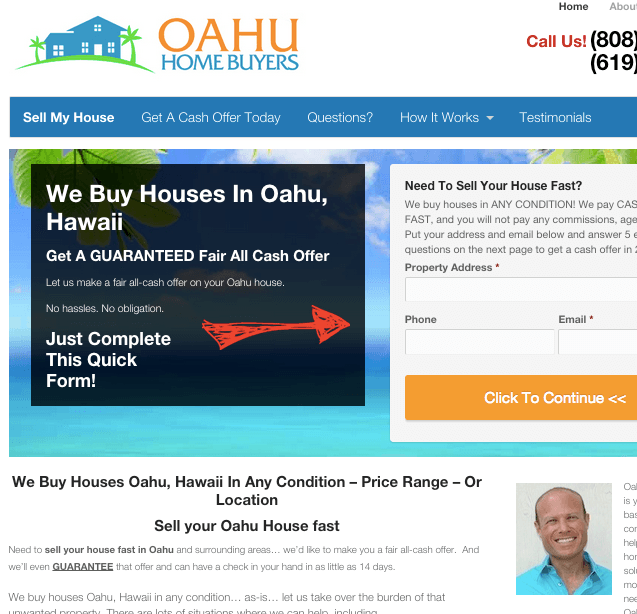
Action Item: Don’t make your website bland! Add in some local pictures, testimonials with pictures, etc.
4. Use Outbound Links
This tip is a total counter intuitive SEO tip… but it’s one we’ve been using for years with a lot of success. It’s not a part of our standard SEO optimization process for our blog posts, our Content Pro articles that our team writes for our members, and other content we write.
An “outbound link” is simply a link on your page that points to another website.
Google uses these outbound links… to credible authority websites like wikipedia.org (see what I just did there ;-), school URLs, etc… to help it know whether you’re in a “nice” neighborhood online or not.
We usually do 1-3 solid outbound links per blog post.
Action Item: In all of your blog posts and main pages you want to rank well… find a wikipedia page that talks about something you mentioned in the article and link to it.
5. Wrap Your Title In An H1 Tag
This is a simple one, but most real estate investors neglect this tip.
Just having your keyword in your title tag usually isn’t enough. One of the next big things Google looks at on your page after the URL and title tag is the rest of the content on your page… starting with any headings.
The “H1” (heading 1) tag is simply the largest heading on your web page and tends to be the heading at the top of the page.
So, start off your page with a version of your keyword phrase in the H1 tag.
6. Drop Keyword In First 100 Words
After Google checks out your URL, title tag, and H1 tag, they move on to your main content. To set the tone for Google as to what that page is about even more, make sure within the first few sentences that you’re including your main keyword once. And as I mention in tip #12 below… mix in some “LSI” keywords as well to really give it that SEO punch.
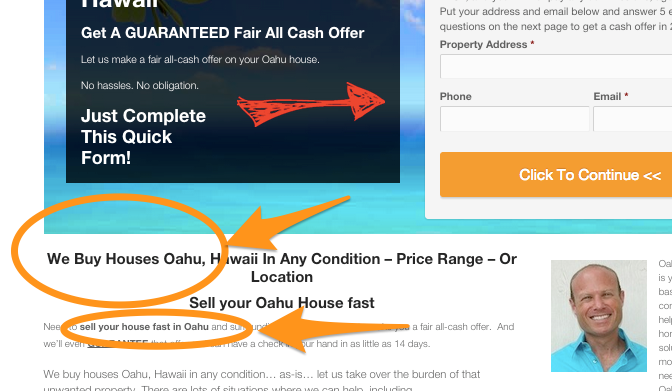 Action Item: When you’re writing the content on your pages… make sure that within the first few sentences you have your main keyword phrase in there… and I always like to inject my secondary keyword phrase in there as well. The content with InvestorCarrot websites is already optimized for your specific city when you launch the sites… and we make sure your content optimized to give you a boost.
Action Item: When you’re writing the content on your pages… make sure that within the first few sentences you have your main keyword phrase in there… and I always like to inject my secondary keyword phrase in there as well. The content with InvestorCarrot websites is already optimized for your specific city when you launch the sites… and we make sure your content optimized to give you a boost.
7. Nail Loading Speed
How fast your website loads on a visitors browser is a big deal. The longer it takes to load the more likely a visitor will hit the “back” button and leave.
Studies have shown that your chances of keeping a visitor on your website go down big time after about 3-4 seconds if the page hasn’t fully loaded yet. So, make sure your website is built with nice clean code from the ground up, your server is fast, and your images on your website are compressed to as small as possible.
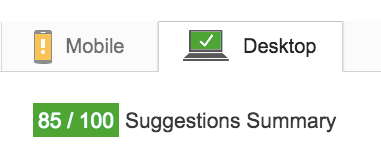
A quick tip. We compress every picture before we upload them to our Carrot websites and these blog posts using a free online tool called Compressor.io. That alone could drastically speed up your page loading speed.
Action Item: Go test your page speed on Googles free tool. If you’re in the “Green” then you’re doing really really well. The screenshot above is from a test we just did on a random customers website. Google’s own homepage only tests to a 91. If the customer wanted to speed it up even more they should compress the images they uploaded.
8. Add Modifiers To Your Title
I’m a huge advocate for using every page to try to rank for 1-2 keywords if possible.
To help do that we add modifiers to our titles and title tags so Google can see what else this page is about.
What we’ll often do for real estate investors is add location based modifiers.
As you can see in the screenshot below of a Google search I just did… Google is serving me up a suggestion in the Fresno market that people are typing the letters “ca” after Fresno. So rather than just using “we buy houses fresno”… make your title tag something more like “we buy houses fresno ca”… to modify the title so you can grab rankings for those searches as well.
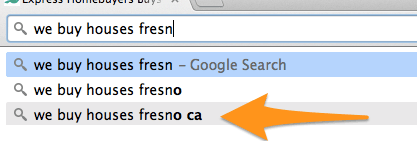
Other modifiers we’ll use a lot away from the real estate market is adding the word “review” after it if we’re talking about a product, etc. Get creative.
Action Item: Go go Google and start typing up your main search phrase really slowly and see what Google serves up to you as a suggested search. If there are any modifiers you can put before or after your keyword, add them to your title tag on your page!
9. Use Social Sharing Buttons
We have been diving in really deep week to week on ranking factors and we walking through what folks needed to do in their markets to outrank their competition. One of those factors consistently popped up as having a positive effect on rankings overall is social signals (backed up by this report showing the strong correlation between social activity and high rankings).
These are things like Facebook “Likes”, Google 1+s, LinkedIn shares, etc.
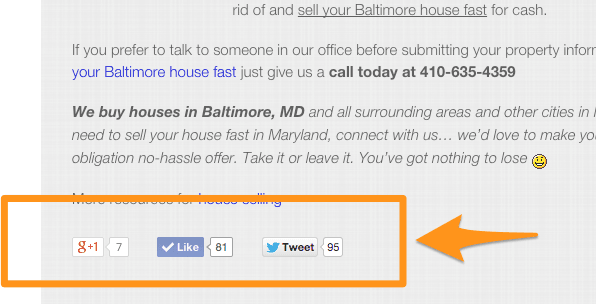
Google uses these signals kind of as mini votes for the website. Google feels that if the page has great content and is getting shared in social media… it must be pretty solid. So it adjusts your search rankings accordingly.
So add some very simple but prominent social media sharing buttons on your websites.
Action Item: Get a Google 1+ button and Facebook button on your website. Ditch the pinterest and twitter share buttons though. Those tend to not fit with the type of visitor real estate investors get to their websites.
10. Post Long Content
Yes, bigger is better in this case (most of the time).
This argument has been going on for as long as marketing has been alive (which is a LONG LONG TIME)… is short copy or long copy better?
In the case of search engine optimization (SEO), studies have shown that longer content on a web page directly correlates with higher rankings in most cases.
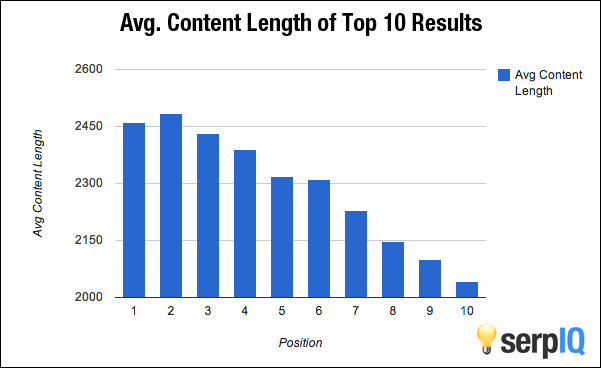
If you’re going after a crazy competitive search phrase… like any cash buyer or motivated seller search phrase in a bigger city like Phoenix… you’ll make it easier on yourself if you’re using a website with robust and engaging content on the website.
We suggest at a minimum that all of your pages that you want to rank well in Google should have at a MINIMUM of 300-500 words.
But if you’re going after a really competitive phrase… build out some more content and see if you can get it over 1,000 words (of course using these optimization tips along the way).
In the long run we really feel that the future of ranking well in Google is robust, useful, and fresh website content.
Action Item: Having a tough time ranking and you’re doing everything else right? Look at the content length on your page and see if you can add some more content to it… then optimize that content for the keywords you’re going after.
11. Slash Bounce Rate
I wrote a post specifically on how important (or unimportant at some times) your website bounce rate can be in SEO.
Time on site and bounce rate are 2 factors out of the hundreds that Google looks at. They’re wanting to deliver the best possible experience to their web searchers and they realize that if a lot of people “bounce” off of a website quickly after they land, that the website likely isn’t very good.
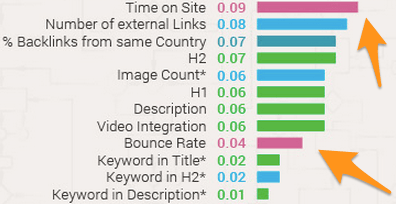
There is a slight positive correlation… to having a low bounce rate and longer than average “time on site” by the visitor… as seen by Search Metrics in this recent report. This picture above is just one part of the full report of all SEO ranking correlations.
The ways you reduce your bounce rate can include…
- Building out more content like we said above… that is useful to the person reading the website
- Adding links on your pages to other resources and pages on your website. This keeps them on your website longer
- Make sure your page loads fast (as we mentioned above)
- Add in engaging media (videos, pictures, graphs, etc)
- Engaging people to click on something
In the end, your aim is to keep someone on your website as long as possible… and/or to get them to visit multiple pages of your site. This increases the engagement of the visitor and increases the chances of conversion.
12. Sprinkle LSI Keywords
This is kind of a fancy term for a very simple concept. LSI means “latent semantic indexing”… which basically means that Google can tell when two words have the same intent so Google treats them in a similar way.
As an example, see the picture below of a search I just did.
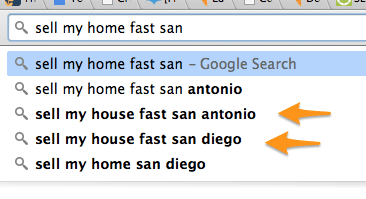
You’ll notice LSI keywords in action above.
In that search I typed the word “home”… but you’ll see in the suggestions how Google is serving me up phrases with the word “house” in them.
Google has looked at trillions of searches and has a pretty darn good idea of what words mean in certain context. In this case Google can tell that “home” and “house” essentially have the same intention.
So when you’re writing your content, make sure to use variations of your main keywords. Don’t always use the same exact keyword in your content.
If your primary keyword is “sell my house fast jacksonville fl”… mix it up. “sell your home fast jacksonville fl”. “sell my home quickly jacksonville fl”. “Buy my house fast jacksonville”
You get the idea. Sprinkle some similar intention phrases into your content. You’ll thank me later.
I hope you got some great tips out of this post that you can implement on your own real estate websites to rank better and get more leads.
Let me know in the comments below how you’re doing with SEO for your own website. Shoot me your domain name in the comments below and I’ll give you some feedback!







